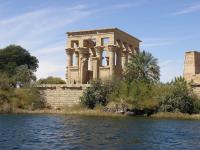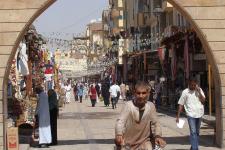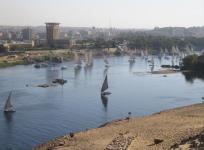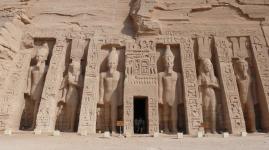
In this VFR - GPS Flight Plan we take off from the aerodrome of Daraw (HE23) [Egypt], fly southwards following the course of the Nile, overfly the Aswan dam and lake Nasser, and land in the airport of Abu Simbel (HEBL) [Egypt].
At the bottom of this page you will find the download link of this Flight Plan (.PLN file)

In this VFR - GPS Flight Plan we take off from
the
aerodrome of Daraw (HE23) [Egypt], fly southwards following the course
of the Nile, overfly the Aswan dam and lake Nasser, and
land in the airport of Abu Simbel (HEBL) [Egypt].
Find below a short extract and screenshots of the main points of the route. In this journey around Africa I have used the Cessna 172S (Skyhawk)

Taking off from the aerodrome of Daraw,
that does not have ATC. Turning southwards in order to follow the course of the
Nile.

Getting back to the Nile

The city of Aswan.
Aswan (Arabic: أسوان) is a city in the south of Egypt, and is the capital of the Aswan Governorate.
Aswan is a busy market and tourist centre located just north of the Aswan Dam on the east bank of the Nile at the first cataract. The modern city has expanded and includes the formerly separate community on the island of Elephantine.
The city is part of the UNESCO Creative Cities Network in the category of craft and folk art. Aswan is a large tourist city where the current population is 1,568,000. (*1)
 |
 |
 |
| Aswan Philae
temple pavilion By Mmelouk - CC BY-SA 4.0 |
Aswan street By Silar - CC BY-SA 3.0 |
View from the
west bank of the Nile, islands, and Aswan By Isewell - CC BY-SA 3.0 |

The Aswan Dam.
The Aswan Dam, or more specifically since the 1960s, the Aswan High Dam, is the world's largest embankment dam, which was built across the Nile in Aswan, Egypt, between 1960 and 1970. Its significance largely eclipsed the previous Aswan Low Dam initially completed in 1902 downstream. Based on the success of the Low Dam, then at its maximum utilization, construction of the High Dam became a key objective of the government following the Egyptian Revolution of 1952; with its ability to better control flooding, provide increased water storage for irrigation and generate hydroelectricity, the dam was seen as pivotal to Egypt's planned industrialization. Like the earlier implementation, the High Dam has had a significant effect on the economy and culture of Egypt.
Before the High Dam was built, even with the old dam in place, the annual flooding of the Nile during late summer had continued to pass largely unimpeded down the valley from its East African drainage basin. These floods brought high water with natural nutrients and minerals that annually enriched the fertile soil along its floodplain and delta; this predictability had made the Nile valley ideal for farming since ancient times. However, this natural flooding varied, since high-water years could destroy the whole crop, while low-water years could create widespread drought and consequently famine. Both these events had continued to occur periodically. As Egypt's population grew and technology increased, both a desire and the ability developed to completely control the flooding, and thus both protect and support farmland and its economically important cotton crop. With the greatly increased reservoir storage provided by the High Aswan Dam, the floods could be controlled and the water could be stored for later release over multiple years.
The Aswan Dam was designed by the Moscow-based Hydroproject Institute. (*1)

We begin flying over the lake Nasser.
Lake Nasser (Arabic: بحيرة ناصر Boħēret Nāṣer) is a vast reservoir in southern Egypt and northern Sudan. It is one of the largest man-made lakes in the world. Before construction, Sudan was against the building of Lake Nasser because it would encroach on land in the North, where the Nubian people lived. They would have to be resettled. In the end Sudan's land near the area of Lake Nasser was mostly flooded by the lake.
Strictly, "Lake Nasser" refers only to the much larger portion of the lake that is in Egyptian territory (83% of the total), with the Sudanese preferring to call their smaller body of water Lake Nubia (Egyptian Arabic: بحيرة النوبة Boħēret Nubeyya, [boˈħeːɾet nʊˈbejjæ]).
The lake is some 479 km (298 mi) long and 16 km (9.9 mi) across at its widest point, which is near the Tropic of Cancer. It covers a total surface area of 5,250 km2 (2,030 sq mi) and has a storage capacity of some 132 km3 (32 cu mi) of water.
The lake was created as a result of the construction of the Aswan High Dam across the waters of the Nile between 1958 and 1970. The lake is named after Gamal Abdel Nasser, one of the leaders of the Egyptian Revolution of 1952, and the second President of Egypt, who initiated the High Dam project. It was President Anwar Sadat who inaugurated the lake and dam in 1971. (*1)

Sometimes the lake is so wide that you can barely see the shores.

After a long flight along the lake Nasser we begin the final approach to the
airport of Abu Simbel.
Abu Simbel is two massive rock-cut temples in the village of Abu Simbel (Arabic: أبو سمبل), Aswan Governorate, Upper Egypt, near the border with Sudan. They are situated on the western bank of Lake Nasser, about 230 km (140 mi) southwest of Aswan (about 300 km (190 mi) by road). The complex is part of the UNESCO World Heritage Site known as the "Nubian Monuments", which run from Abu Simbel downriver to Philae (near Aswan). The twin temples were originally carved out of the mountainside in the 13th century BC, during the 19th Dynasty reign of the Pharaoh Ramesses II. They serve as a lasting monument to the king Ramesses II. His wife Nefertari and children can be seen in smaller figures by his feet, considered to be of lesser importance and were not given the same position of scale. This commemorates his victory at the Battle of Kadesh. Their huge external rock relief figures have become iconic.
The complex was relocated in its entirety in 1968 under the supervision of a Polish archaeologist, Kazimierz Michałowski, from the Polish Centre of Mediterranean Archaeology University of Warsaw, on an artificial hill made from a domed structure, high above the Aswan High Dam reservoir. The relocation of the temples was necessary or they would have been submerged during the creation of Lake Nasser, the massive artificial water reservoir formed after the building of the Aswan High Dam on the River Nile. The project was carried out as part of the UNESCO Nubian Salvage Campaign. (*1)
 |
 |
 |
| The Great Temple of Ramesses II (left) and the Small Temple of Hathor and Nefertari (right). By youssef_alam - CC BY 3.0 |
The Small Temple after relocation By Ad Meskens - CC BY-SA 3.0 |
Facade of the Temple of Ramesses II By Than217 |
You can download for free this Flight Plan but only for your own private use. It is strictly forbidden to share it or publish it in other sites, forums, newsgroups or in any other way . You are encouraged to share and publish links to this page only, but not direct links to the file itself.
(*1) Credits: The descriptive texts are mainly an excerpt of those provided by Wikipedia. Visit Wikipedia to read the full descriptions.
See other MS Flight Simulator flight plans and instructions
Disclaimer: These instructions and flight plan are intended to be used only for MS Flight Simulator and should not be used for real flights.